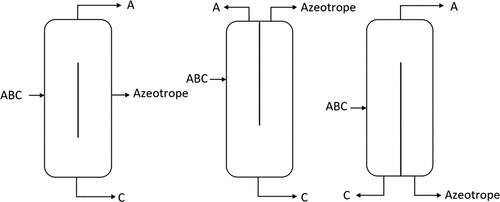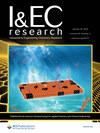Energy and Economic Evaluation of Wall Placement for Divided Wall Distillation Columns
IF 3.8
3区 工程技术
Q2 ENGINEERING, CHEMICAL
引用次数: 0
Abstract
Divided wall columns (DWC) implemented as a form of process intensification for conventional distillation configurations for azeotropic systems normally use an entrainer for breaking the azeotrope. By contrast, this study uses water/isopropanol/acetone as a model chemical system with the goal of having a water/isopropanol azeotropic composition as one of the products. The direct conventional and indirect conventional sequences and middle wall DWC, top wall DWC, and bottom wall DWC were investigated by Aspen Plus simulations, which allowed for product composition, economic, and energy usage comparison between the distillation configurations. The effect of wall placement on economics and energy usage was evaluated for the model chemical system. All of the distillation configurations produced the same product compositions with the middle wall DWC having the lowest associated economic and energy cost. The middle wall DWC had at least 8% fixed capital investment and 14% energy savings compared to the conventional sequences. The location of the dividing wall affected the economic and energy costs, with the middle wall DWC still having the lowest associated costs.

分壁蒸馏塔壁布置的能量和经济性评估
作为共沸系统传统蒸馏配置的一种工艺强化形式,分壁塔(DWC)通常使用夹带器来打破共沸。相比之下,本研究使用水/异丙醇/丙酮作为模型化学系统,目的是将水/异丙醇共沸物作为产品之一。通过 Aspen Plus 模拟研究了直接常规和间接常规顺序以及中壁 DWC、顶壁 DWC 和底壁 DWC,从而对蒸馏配置之间的产品成分、经济性和能源使用进行了比较。对模型化学系统进行了评估,以确定壁布置对经济性和能源使用量的影响。所有蒸馏配置都产生了相同的产品成分,而中间壁 DWC 的相关经济和能源成本最低。与传统顺序相比,中间壁 DWC 至少可节省 8% 的固定资本投资和 14% 的能源。分馏壁的位置会影响经济和能源成本,但中壁 DWC 的相关成本仍然最低。
本文章由计算机程序翻译,如有差异,请以英文原文为准。
求助全文
约1分钟内获得全文
求助全文
来源期刊

Industrial & Engineering Chemistry Research
工程技术-工程:化工
CiteScore
7.40
自引率
7.10%
发文量
1467
审稿时长
2.8 months
期刊介绍:
ndustrial & Engineering Chemistry, with variations in title and format, has been published since 1909 by the American Chemical Society. Industrial & Engineering Chemistry Research is a weekly publication that reports industrial and academic research in the broad fields of applied chemistry and chemical engineering with special focus on fundamentals, processes, and products.
 求助内容:
求助内容: 应助结果提醒方式:
应助结果提醒方式:


